|
The Schuberth/Induyco helmet commonly known as the 826,
and first appearing with the German Bundeswehr in the 1990s, is
now used by a a number of European nations. Many of these have
slight variations, mostly in the area of chinstraps and fastenings,
and absolute identification can be difficult.
This is a beginning
at sorting this out.
|
|
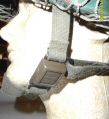
BELGIAN - left chinstrap catch
|
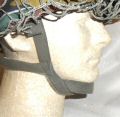
BELGIAN - right chinstrap catch
|
|

BELGIAN - liner rivet and helmet rim
|
|
|

DANISH - left chinstrap catch
|

DANISH right chinstrap catch
|
|
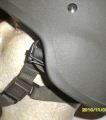
GERMAN - left chinstrap catch
|
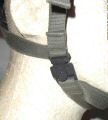
GERMAN - right chinstrap catch
|
|
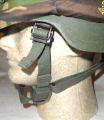
NETHERLANDS - left chinstrap catch
|
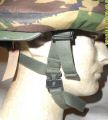
NETHERLANDS - right chinstrap catch
|
|
|
Photographs supplied by
ROGER
LUCY
|
|

NETHERLANDS - B826, known as M95 NL, left Induyco, right early
Schubert
|
|
 006_tm.jpg)
NETHERLANDS - stamp inside Induyco M95
IYCO = INDUYCO
M
= size
month and year of production
MVD = MoD
|
 008_tm.jpg)
NETHERLANDS - Induyco M95 chinstrap set.
|
|

NETHERLANDS - part of chinstrap of first model, note no
quick release buckle.
|
The first compo helmet was the Schubert. It was
delivered in UN blue only. These helmets were manufactured by Schubert
and had ballistic bolts. You can recognize that by them being oblong.
The first helmets did not have the "quick release arrowhead"
buckle. In 1995 in Bosnia the blue Schuberts and the blue Induyco's
were spray painted in an olive colour, or simply covered with olivedrab
tape.
The later helmets were made by INDUYCO and had round
bolts and the typical "quick release arrowhead" buckle.
This helmet was named M95. The MoD did not order these early Schuberts
according to EU rules so further Schubert orders had to be cancelled.
Induyco won the next bid.
The M95 in use by the army did not have the lock
on the "quick release" buckle. Only the Marine Corps were
issued these helmets with a lock, for parachute operations.
Emile
Verbunt
|
|
|
Photographs supplied by
EMILE VERBUNT
|
Some notes regarding variations
of the 826 as used internationally, compiled by ADRIAN BLAKE, this
version dated September 2010.
|
|
ALBANIA - ???
|
|
AUSTRIA - Schuberth - 3 examples. Army -
light brown with sand-texture, size is marked in S, M and L also
in metric size like 56-58 inside white stencil inside a rectangle
"Schuberth Helme 826 1993 Gr. 56-58", chinstrap is the
same as the sample used in the Bundeswehr steel-helmet with quick
release buckle, suspension NOSHA, bolts are single-holed (round)
metal. Gendarmerie - light grey with sand-texture,
size is marked in metric eg 55-57, inside white stencil "Schuberth
826 Gr. 2". Chinstrap has locking catch to left side of chinstrap
opposite "Press" catch on right side. Suspension NOSHA,
bolts are black ballistic bolt heads in rectangle shape. Special
Forces - dark-blue with sand-texture, size is marked in
metric eg "55-57" inside white stencil "Schuberth
826 Gr. 2". Chinstrap has locking catch to left side of chinstrap
opposite "Press" catch on right side. Suspension NOSHA,
bolts are black ballistic bolt heads in rectangle shape
|
|
BAHREIN - Schuberth - Sand coloured, protection level
550 m/sec, sand coloured chin strap + basic US M1-type suspension.
"Schuberth" in black inside.
|
|
BELGIUM - designated M95 - made by Schuberth
(?). Smooth outer surface, black plastic bolt heads. SAE
(contract?) number, "ABL" & date inside
|
|
BRUNEI - ???
|
|
CZECH REPUBLIC - Schuberth
|
|
DENMARK - Schuberth - Green (smooth) helmets trialed but
rejected. UN Blue helmets used for UN purposes. White "Schuberth"
stencil inside right side showing makers name, "826",
date (mm/yy) and size. Trial versions believed to be marked with
helmet size only.
|
|
GERMANY - designated B826 - Schuberth & Induyuco
- Slightly rough outer surface in BW olive green. Locking catch
to left side of chinstrap opposite "Press" catch on right
side. Bolts are single-holed (round) metal. "Bund"
stencil in white to inside incorporating makers initials and date
["SH99" = Schuberth, 1999] and a NATO stock number which
incorporates a country code [12 = Germany]). Induyuco model only
has size applied . More coarse chin-strap material and suspension
bolts are single-holed metal spanner bolts.
|
|
KOSOVO -???
|
|
LUXEMBOURG - ???
|
|
MACEDONIA - ???
|
|
NETHERLANDS - designated M1995 - Schuberth & Induyuco
- Schuberth UN blue only 1994-1996. Induyco green from 1996. Rough/"Sand-textured"
medium-green outer surface. Generally no "lock" to quick-release
catch to left side of strap (opposite "Press" catch on
right side) but a lock device is used by Dutch Marines for added
security when jumping. The chinstrap without "quick release"
device was installed on the first helmet batch the Dutch used ie
the Schuberth-made UN blue ones. Chinstraps with "quick release"
devices were installed on later batches but still without the lock
- the chinstrap material being more coarse than the Indoyuco model.
The blue Schuberts with oblong rivets, were resprayed in flat smooth
olive - the new paint does not adhere well to the rim and signs
of wear can be seen very early on. Schuberth models have a white
stamp to the inner skirt showing maker, NATO stock number, date
and size. Indoyuco models (1996 - present) have black decal to inner
crown eg "Loti 04 L 09/96" and "INDUYUCO MVD"
incorporated into moulding of vertical liner suspension piece (rear).
White-shelled versions used by non-operational units - white
ensured they weren't used in combat.
|
|
NORWAY - designated M1994 - White "SCHUBERTH"
stencil to inner left side. No quick-release catch to left side
of chin strap.
|
|
PAKISTAN - ???
|
|
ROMANIA - ???
|
|
TURKEY - ???
|
|
|
|
International Organisations -
INTERNATIONAL RED CROSS -
at least some examples sent to IRC in Geneva
|









 006_tm.jpg)
 008_tm.jpg)
